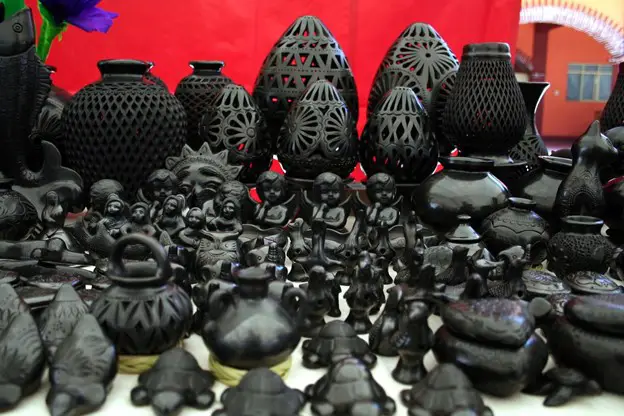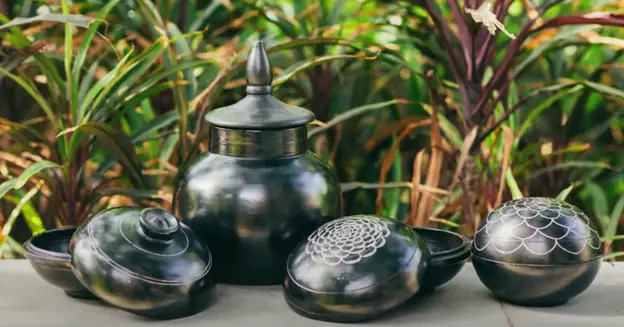When learning the basics of pottery, you will come across several terms. Some you might understand well, others you won’t. Among these lesser-known terms is black clay. Beginner potters are confused between the differences and similarities between stoneware, black clay, white clay, & earthenware clay. To understand more about black clay, we will first decode whether or not it is natural. If natural, we will discuss its occurrence. If not, we will learn about the best ways to make black clay.
Discussing the Origins of Black Clay
Black clay pottery is also known as Barro Negro Pottery. It comes from a Mexico-based state which is Oaxaca. This clay variant can also be made from powdered pigments termed Mason Stains. Black clay has existed for quite some time, and it isn’t actually completely black. It has a well-tinted dark brown hue. Clay, when fired regularly, tends to retain its natural color. However, when gas is used in the firing process, the clay turns a dark brownish color.

This doesn’t mean that black clay cannot be completely black. There is a process to it. A popular pottery artist, Dona Rosa, during her pottery escapades, found that this dark brown hue can be turned black with a simple process. Before firing the clay pieces in a kiln, they should be rubbed completely from end to end with quartz crystals.
Once this happens, when the clay piece is fired, it turns into a shiny and polished dark black shade.
What Gives Black Clay its Color?
Given the natural properties of the popular earthen clay, black color can be found in it. This is completely natural & not shaded or colored at all. Black clay is extracted naturally from this earthen clay. It is passed through an elaborate cleaning process that eliminates & takes away all of its impurities.
In this cleaning procedure, an entire month of clay drenching is involved. Next, the remnant clay is settled, filtered, & cleaned out. This is the best way to extract black clay from earthen clay while retaining its black hue.
Black Clay: Is it Natural?
Given the fact that black clay is filtered out from naturally-occurring earthen clay, it can safely be said that it is completely natural. However, this doesn’t mean that it cannot be manufactured artificially.
If you are a potter that wishes to create artwork from authentic & true black pottery clay, this can be done with clay acquired only from Mexico. Here you can find naturally harvested black clay. In order to create a dark black finish for the pottery piece, smoke must be infused into the clay via carbon.
Potters make use of slip added to a plane clay surface to create black pottery pieces with intricate designs. To produce complete black color with black clay pottery, the structure and particles of clay should be particularly fine.
Now that you know the basics of black clay let us learn the right way to create black clay.
Steps to Make Black Clay
Simply put, black clay, when manufactured, would require 30 g of stain to add color to 500 g of clay. Black clay tends to be unique and is found in a dry piece form. Post extraction, these clay pieces are laid out under the direct sun to remove all the moisture content. This helps dry it out to a powdered form. To clean all the clay impurities, it needs to be absorbed within water tubs after the clay cleaning process is completed.
This clean clay is then passed through a manual mixing process. To get an ideal consistency, black clay has to be squeezed and kneaded repeatedly. Black clay is mud-rich and contains minerals like montmorillonite. If you don’t want to go through the process of preparing black clay, you can opt for the Van Aaken Modeling Clay. This highly pigmented modeling clay has a smooth consistency with brilliant colors post-firing.
How is Black Clay different from White Clay?
One thing that will tempt you towards using white clay is the fact that it is termed Kaolin. It has an extremely soft and fine texture. Moreover, white clay comes in light powdered form with a spongy property. This clay can be mined and extracted at the very same location. The reason it is termed prime clay is that it isn’t carried downstream for further processing.
White clay contains low iron content, which makes it a primary option for pottery. On the contrary, black clay comprises a large amount of manganese along with different important minerals. Certain black clay variants are comprised of carbon-based mixtures like Fe, Mg, & other metals.
The black clay cleaning process is very prolonged as it requires soaking & settling for an entire month. Even after completion of the clay cleaning cycle, creating a piece of high-quality black clay would require 20 more days. Black clay can be used to create different types of items that include whistles, pots, lamps, masks, woodwinds, figurines, and more.
White clay tends to be soft & fine when compared to black clay. Rocks that contain a good amount of kaolinite are termed china stone or kaolin. The porcelain production process requires the use of white clay. White clay is also used to produce several products such as rubber, paper, paint, and so on. Another factor that differentiates white clay and black clay is workability. White clay has better workability as compared to black clay, given its rapid water absorption rate. Even a small amount of moisture added to the clay can change the workability.
White Pottery Clay |
Black Pottery Clay |
| Found mostly in China | Found mostly in Oaxaca, Mexico |
| Kaolin | Barro Negro Pottery |
| Lower plasticity | High shrink-swell feature |
| More manageable with the absence of iron | Not as manageable as it is high in Fe and Mg |
| Absorbs water very easily | Absorbs water slowly compared to white clay |
Conclusion
The process of making black clay can be very intricate. Make sure you get some training and information from trained artists before you attempt the same. In case you simply plan to create a black exterior, it is advisable that you prepare a black clay slip that contains about 15 percent stain. This process is highly preferred by potters and tends to be less expensive as compared to shading the entire clay piece.








